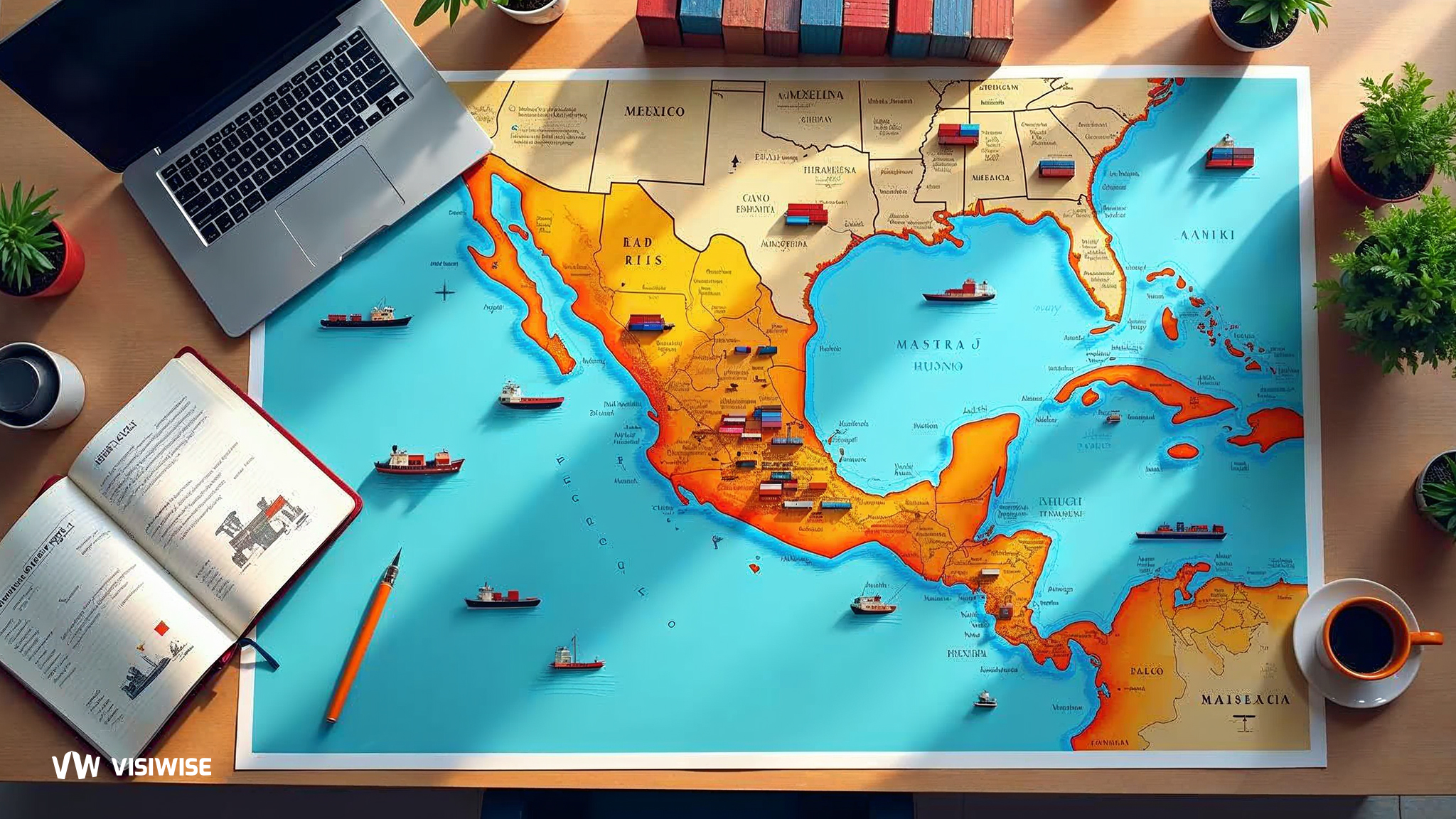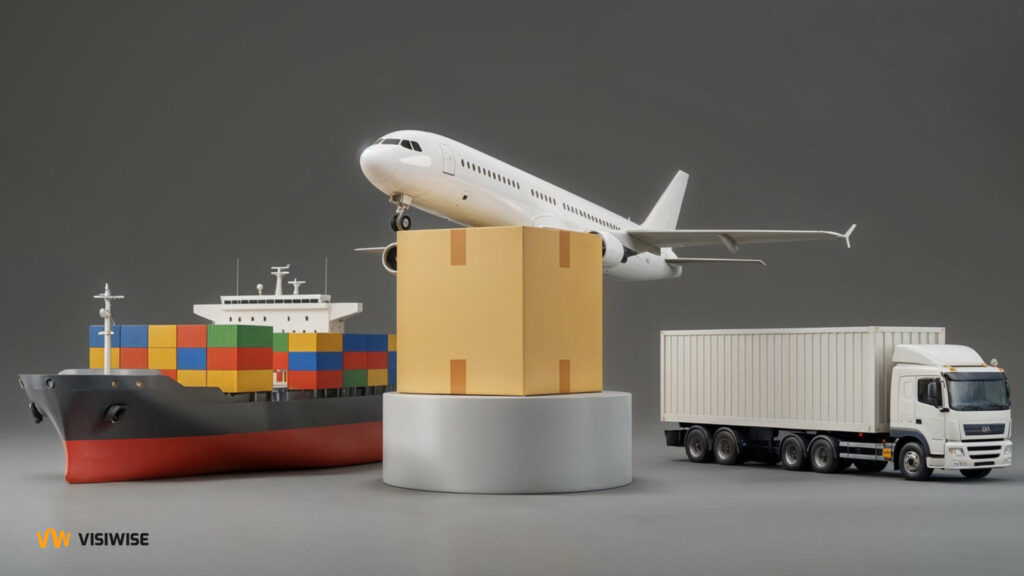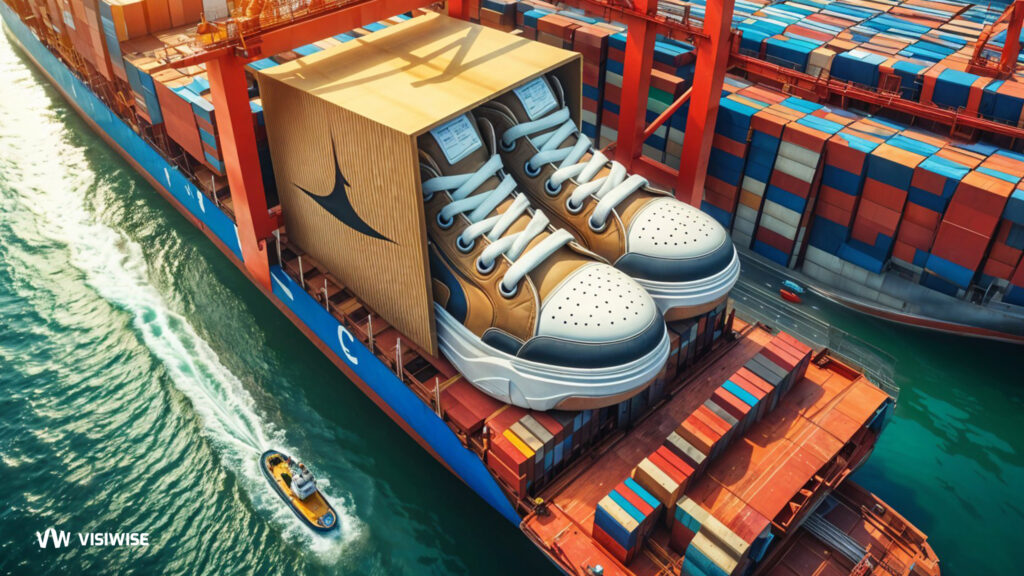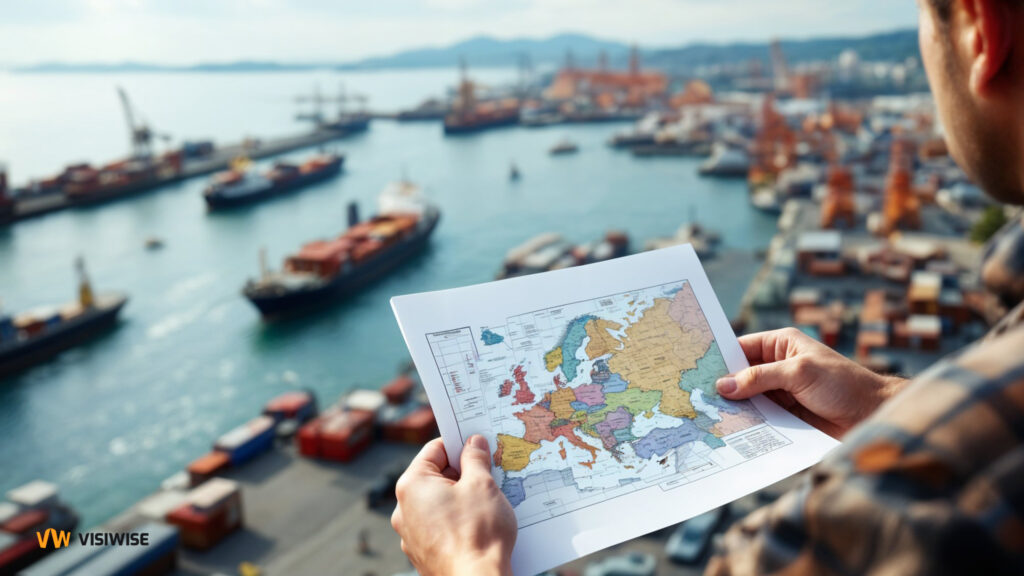Mexico’s seaports are vital components of its thriving international trade network, leveraging the country’s strategic position in the global economy. With over 11,000 kilometers (approximately 7,145 miles) of coastline and a National Port System that includes 117 ports and terminals, these maritime hubs serve as gateways connecting Mexico to 145 countries worldwide. Handling 80% of the nation’s international commerce, the ports play a crucial role in positioning Mexico as the 13th largest export economy globally and the 11th largest exporter by volume.
Among these ports, Veracruz, Altamira, Manzanillo, Lázaro Cárdenas, and Ensenada are particularly notable for their advanced infrastructure and cargo handling capabilities, consistently managing the largest volumes of goods. Supported by extensive highway and railway networks, these ports ensure seamless transport of goods across industries and continents, reinforcing Mexico’s role as a cornerstone of global logistics.
A Growing Maritime Hub
Recent investments have transformed Mexico’s port infrastructure, doubling its capacity and improving efficiency across the board. These upgrades have elevated the ports’ ability to manage diverse cargo types, ranging from industrial materials to consumer goods. In 2020, Mexico imported $368 billion worth of goods, demonstrating the critical importance of its ports in sustaining such high levels of trade activity.
This enhanced infrastructure doesn’t just benefit Mexico; it bolsters international supply chains by reducing transportation costs and ensuring timely deliveries. As the second-largest economy in Latin America and an upper-middle-income nation, Mexico’s seaports are more than just trade hubs—they are engines of economic development and global connectivity.
Manzanillo Port: Mexico’s Pacific Trade Powerhouse
The Port of Manzanillo, located in the state of Colima on Mexico’s Pacific Coast, is the country’s largest and busiest port. Serving as a critical gateway for international trade, it connects Mexico’s western and central industrial regions, including the vital commercial hub of Mexico City. Manzanillo’s strategic importance is underscored by its handling of 40% of Mexico’s container traffic as of 2023 and its position as a primary entry point for goods entering the nation.
In 2022, the port managed approximately 31 million tonnes of cargo and 3.474 million TEUs, reflecting a 3% growth compared to the previous year. Historically, it handled 48% of Mexico’s total shipments in 2021, marking a 15.9% increase in container activity with 3.37 million TEUs. A $230 million expansion project has boosted the port’s capacity from 1.4 million to 2 million TEUs over five years, reinforcing its role in international logistics.
Infrastructure and Economic Contributions
Spanning 437 hectares, the port features 19 operational berths divided into specialized terminals, including breakbulk, international container, oil, and passenger terminals, capable of accommodating the largest cruise ships. It maintains direct shipping connections with 125 ports in over 40 countries, including major trading partners like the United States, Canada, China, and Germany.
Manzanillo serves as a key export hub, shipping products such as fish, corn, lemons, bananas, wine, lumber, cement, and canned foods. It also offers repackaging services for goods like clothing, shoes, and chemicals. On the import side, the port handles diverse cargo, including wheat, sorghum, fertilizers, sulphur, and zinc concentrates.
Beyond trade, the port significantly impacts Colima’s economy, generating more revenue from foreign commerce than local trade or tourism. The recent establishment of the Association of Terminals and Operators of Manzanillo (ASTOM) aims to drive further growth, with projections for substantial expansion by 2045 and the creation of 35,000 new jobs, cementing Manzanillo’s role as both a logistical powerhouse and an economic catalyst.
Lázaro Cárdenas Port: A Deepwater Gateway for Global Commerce
Situated on the Pacific Coast in Michoacán, the Port of Lázaro Cárdenas is a strategic hub for international commerce and Mexico’s second busiest port. Its deepwater capabilities, featuring an 18-meter-wide access channel, make it the only Mexican port capable of accommodating the largest cargo vessels with a maximum displacement of 170,000 tonnes.
In 2022, the port handled approximately 29 million tonnes of cargo and 2 million TEUs, marking a significant contribution to the country’s logistics network. A major driver of its growth is the automotive industry, which set a record by moving 646,000 automotive units—a 40% increase over 2021. This momentum continued into 2023, further reinforcing Lázaro Cárdenas’ role as a crucial player in Mexico’s trade and industrial activities.
Infrastructure and Industrial Significance
Spanning 1,500 hectares, the port is a versatile industrial hub with space for new businesses and terminals. It boasts 22 wharves distributed across five public terminals—specializing in grains, containerized goods, and general cargo—and four private terminals for bulk minerals, fluids, coal, and fertilizers. Plans to expand its annual TEU capacity to 2.2 million, with an ambitious goal of reaching 4.1 million TEUs by 2030, underline its growing importance in global logistics.
Lázaro Cárdenas serves as a critical export hub for iron plates, steel bars, phosphate, and container goods while importing materials like pellets, pig iron, sulfur, grains, and fuel products such as gasoline and diesel. Its integration with road and rail networks, including exclusive service by Kansas City Southern Railway, enhances connectivity and makes it an attractive alternative to congested U.S. ports.
Ongoing infrastructure projects, including pier construction, channel dredging, and road improvements, position Lázaro Cárdenas as a dynamic and adaptable port. These advancements not only improve efficiency but also solidify its reputation as a leading gateway for trade in the Pacific region.
Ensenada Port: Linking Baja California to the World
Nestled on the Pacific coast in Baja California, the Port of Ensenada serves as a vital maritime hub connecting Northern Mexico to international markets. Just 110 kilometers (80 miles) from the U.S.-Mexico border and close to San Diego, California, its strategic location near Todos Santos Bay positions it as a key player in regional and global trade. Established as an industrial harbor in the early 1900s, Ensenada has grown into a multi-purpose port, accommodating both commercial cargo and passenger vessels.
In 2021, the port handled 394,911 TEUs, underscoring its importance in the logistics network. Ensenada connects to 64 ports across 29 countries, primarily facilitating trade with Asia, North America, and South America. Its role as a cruise terminal also highlights its dual functionality, attracting major cruise lines and tourists exploring the natural wonders of Baja California, such as the renowned La Bufadora blowhole.
Infrastructure and Connectivity
The Port of Ensenada is supported by robust transport infrastructure, linking it to major trade routes and cities in Mexico and the U.S. Federal highways, including the Tijuana-Ensenada and Tecate-Ensenada routes, connect the port to key urban centers such as Tijuana, Tecate, and Mexicali—major U.S. border crossings. These highways ensure efficient movement of goods, integrating the port into North America’s broader logistics framework.
The port’s facilities include deepwater docks, cargo terminals, and cruise ship berths, enabling it to handle diverse maritime activities. Its advantageous location near the Pacific Rim grants it access to critical international shipping routes, enhancing its role in global trade. With a focus on sustainability, Ensenada also employs eco-friendly waste management systems, balancing economic activity with environmental stewardship.
As a vital link between Mexico, the U.S., and the wider Pacific region, the Port of Ensenada continues to thrive as a versatile and strategically significant maritime hub.
Altamira Port: Petrochemical Leader and Trade Catalyst
Located on the eastern coast of Mexico along the Gulf of Mexico, the Port of Altamira stands as a key gateway for international trade and industrial activity. Established in the late 1980s, Altamira has developed into a major logistics hub, covering 1,600 acres and connected to 125 ports worldwide, predominantly along the Atlantic coast. Its strategic location facilitates trade with Mexico’s northern and central regions, linking cities such as Monterrey, Guadalajara, and Mexico City through extensive rail and road networks.
In 2021, Altamira handled 1,550 ships and processed 12.18 million tons of cargo, including 397,000 TEUs. While overall cargo volumes slightly decreased in 2022 to 1.65 million metric tonnes, the port continues to excel in specialized industries. It is the top port for petrochemical fluid handling and ranks second for automobile movement in the Gulf of Mexico.
Infrastructure and Economic Significance
The Port of Altamira features a large, modern container terminal with four docks and 14 marine terminals within the Altamira Industrial Port Complex. Annually, it manages nearly 22 million tons of cargo, with a focus on petrochemicals, LNG, bulk goods, and containerized shipments. A significant portion of its cargo serves industrial zones in Tamaulipas, Nuevo León, Coahuila, and central regions like Guanajuato and Querétaro.
Altamira’s growth is bolstered by a $200 million modernization effort, including the construction of Mexico’s most advanced fuel terminal. Its proximity to industrial giants like BASF and POSCO further underscores its economic importance. In addition to industrial contributions, Altamira is a hub for job creation, environmental initiatives, and tourism, attracting nature enthusiasts and sports fishers.
With its robust infrastructure, strategic location, and focus on industrial development, Altamira continues to strengthen its position as a leading port on Mexico’s Gulf Coast, facilitating both domestic and international commerce.
Veracruz Port: Mexico’s Historic and Modern Maritime Hub
Situated on the Gulf Coast of Mexico near the Bay of Campeche, the Port of Veracruz combines centuries-old historical significance with modern-day economic relevance. Established by Hernán Cortés in the 16th century, it was a critical port during Spanish colonization, facilitating the export of local goods like corn and avocados while importing essential items from Europe. Today, it is one of Mexico’s leading commercial ports, serving as a vital link for international trade, particularly in agricultural bulk, automobiles, and containerized goods.
Positioned just over 300 kilometers from Mexico City, the port is integral to the country’s central and southern regions and has direct connections to North and South America, Europe, and Africa. In 2022, the port handled 2.59 million metric tonnes of cargo, a growth from 2.37 million tonnes in 2021, and remains an essential hub for diverse goods such as grains, chemicals, vehicles, and machinery. Its strategic importance extends to the automotive industry, providing a key export point for manufacturers in Puebla.
Infrastructure and Expansion
The Port of Veracruz spans 4,500 meters of wharves across 11 docks and is equipped with Mexico’s only X-ray and gamma-ray scanning systems, ensuring efficient and secure cargo handling. Despite being overtaken by the Port of Manzanillo as the country’s largest port in 2005, Veracruz maintains a leading position in agricultural and automobile shipping.
Ongoing expansions highlight its commitment to growth, including a $160 million investment to construct Latin America’s longest breakwater at 4.3 kilometers. The project, which includes five new terminals and 35 berths, aims to increase the port’s annual capacity from 28 million to 95 million tonnes. Alongside its modern infrastructure, Veracruz remains a center for cultural events like Carnaval, showcasing its blend of historical charm and modern functionality.
From its colonial roots to its current role as a major trade hub, the Port of Veracruz epitomizes the evolution of maritime commerce in Mexico. Its balance of historical significance and future-focused development ensures its continued importance in international trade.
Coatzacoalcos Port: Mexico’s Oil Powerhouse
Situated at the Gulf of Mexico’s edge, where the Coatzacoalcos River meets the sea, the Port of Coatzacoalcos is Mexico’s leading oil hub. This natural harbor features two key sections: the free port on the river’s western bank and the Pajaritos Oil Port, managed by Pemex. With 8 conventional berths and 9 tanker berths, the port handled 2.53 million metric tonnes of cargo in 2022. It primarily exports petroleum products from Minatitlán, along with forest goods, agricultural products, and consumer items.
The port’s infrastructure includes a liquefied gas terminal with 7 specialized wharves for gas carriers and oil tankers, as well as storage facilities for bulk, container, and general cargo. Coatzacoalcos is a vital transport hub, connected by rail to major cities like Mexico City and Mérida, enhancing its strategic importance in national and international trade.
A History of Industrial Evolution
With roots tracing back to 1825, the Port of Coatzacoalcos has evolved alongside Mexico’s economic shifts. During the 20th century, it became a focal point for the oil and petrochemical industries, driven by projects such as the Minatitlán-Salina Cruz oil pipeline and the development of petrochemical complexes. These advancements cemented its position as a key player in the global oil sector.
Looking ahead, a planned investment of $4-5 billion aims to transform Coatzacoalcos into a significant LNG export hub. This project highlights the port’s adaptability and resilience, ensuring its continued relevance in Mexico’s economic landscape while further expanding its role in international trade.
Tampico Port: A Historical Gateway for Varied Cargo
Located at the mouth of the Pánuco River in Tamaulipas, just 10 kilometers from the Gulf of Mexico, the Port of Tampico boasts a legacy that dates back to its establishment as a Spanish colonial port in the late 18th century. During the early 20th century, the discovery of oil in the region transformed Tampico into a key player in the petrochemical industry. Its modern infrastructure, designed for oil and gas shipments, solidifies its role as a cornerstone of Mexico’s petrochemical sector.
Tampico has expanded its capabilities to handle diverse cargo types, reflecting its adaptability to evolving economic demands. In 2022, the port managed 650,000 metric tonnes of goods, contributing to an annual cargo throughput of approximately 8.8 million tonnes, including 11,000 TEUs.
Infrastructure and Global Connectivity
The Port of Tampico is a bustling maritime hub with 24 berths, drydocks, and shipyards located along the southern bank of the Pánuco River. It includes 2 tanker terminals operated by Pemex and facilities for constructing marine oil rigs. The port also has 6 private and 2 public terminals.
Storage facilities at Tampico are extensive, featuring 38,000 m² of warehouses, 6,500 m² of sheds, and 330,000 m² of open yards for general cargo. Connected by 20 major shipping lines, Tampico links to 100 global ports across nations like the United States, Canada, Brazil, and Singapore, solidifying its position as a critical gateway for petrochemical and industrial products, including steel, wood, molasses, and metals.
Guaymas Port: A Key Maritime Hub for Trade and Agriculture
The Port of Guaymas, located in southwestern Sonora at the mouth of the Rio Yaqui, is a significant maritime gateway to the Gulf of California. Established in 1769, it plays a crucial role in exporting copper, sulfuric acid, and various agricultural products, including cotton, corn, soy, livestock, and wheat. In 2022, the port handled approximately 600,000 metric tonnes of cargo, solidifying its importance in Mexico’s mining and agricultural sectors. Despite challenges in the fisheries industry, due to overfishing and declining freshwater levels in the Colorado River, Guaymas remains a key player in international trade and the export of agricultural and mineral goods.
Infrastructure and Operations
Spanning 90 hectares, Guaymas Port boasts one of the world’s best natural harbors, supported by six wharves for diverse cargo handling. The port facilitates the transport of general cargo, including wood, steel, and RORO, alongside liquids such as petroleum, diesel, sulfuric acid, ammonia, and fish oil. It also handles metals like copper and magnetite. Situated just 400 km from the U.S. border, Guaymas serves as a vital industrial, shipping, and tourism hub for Mexico, offering robust infrastructure to support regional and international trade.
Mazatlán Port: A Vital Hub for Trade and Tourism
Mazatlán, a coastal city in the State of Sinaloa, has undergone significant transformation since its early days as a small fishing village. Today, it stands as one of Mexico’s key maritime trade hubs, with a thriving port that connects the Pacific coast to international markets in Asia, Europe, and the Americas. Established as a commercial port in the late 1990s, Mazatlán Port has become an essential gateway for goods flowing between Mexico and the world. In 2022, the port handled 300,000 tonnes of cargo, including 33,314 TEUs, underscoring its importance in facilitating the movement of a wide range of goods.
While Mazatlán’s economy has historically been rooted in agriculture and fishing, particularly with its second-largest commercial fishing fleet in Mexico, the port has expanded its scope to accommodate various industrial sectors. Key exports include fish meal, food products, and brewing materials, along with a variety of industrial cargo such as rolled steel, containers, and automobiles. The port’s versatility is reflected in its capacity to handle both commercial goods and tourism-related activities. Mazatlán is known for its vibrant tourism industry, attracting travelers with its golden sand beaches, rich cultural heritage, and dynamic waterfront, which includes an international cruise terminal. The port’s dual role as both a tourist destination and a commercial hub highlights its growing significance in Mexico’s maritime trade.
Infrastructure and Operations at Mazatlán Port
Mazatlán Port boasts a robust infrastructure designed to accommodate a diverse range of vessels and cargo types. It has 12 berthing facilities, with a total quay length of 1,426 meters, allowing it to handle general cargo vessels, container ships, tankers, and ferries. The port is well-equipped to serve a variety of industries and can efficiently process both bulk goods and specialized cargo. Its 2,500-meter-long access channel, with a depth of 12 meters, ensures that larger vessels with a length overall (LOA) of up to 300 meters can navigate the port with ease.
The port’s logistics capabilities are further strengthened by its extensive storage facilities. Mazatlán Port contains six warehouses covering 15,000 m², which are used for storing loose cargo. Additionally, it has two yards dedicated to automobile storage and a 90,000 m² cold storage shed for perishable goods, such as seafood, essential for its thriving fishing industry. These storage and handling facilities are crucial in supporting Mazatlán’s role as a major gateway for both imports and exports, facilitating the smooth flow of goods to and from Mexico.
Topolobampo Port: Strategic Gateway for Agriculture and Trade
Located in the state of Sinaloa on Mexico’s Pacific coast, Topolobampo Port serves as a critical maritime gateway for agricultural and industrial exports. Situated approximately 365 kilometers northwest of Mazatlán, the port is strategically positioned in one of Mexico’s most fertile regions, producing half of the country’s agricultural output. As a result, Topolobampo is a key player in the export of agricultural products such as wheat, soy, sorghum, vegetables, fruits, and livestock. The port is essential for the regional economy, providing a direct outlet for the export of these goods to global markets, including countries in Asia, the Americas, and beyond.
The port’s operations are anchored in its ability to handle a variety of cargo types. It has four private terminals dedicated to general cargo, containers, oil products, LPG, and ammonia. With more than 10 berthing facilities, including specialized areas for fishing vessels, Topolobampo efficiently accommodates the region’s diverse trade needs. The port processed around 410,000 metric tons of cargo in 2022, a slight decline from 450,000 metric tons in 2021, highlighting its consistent role in handling significant trade volumes despite fluctuations.
Infrastructure and Connectivity
Topolobampo Port’s infrastructure is designed to support a wide range of maritime activities. The port features over 10 berthing facilities, with five dedicated to fishing wharves covering 600 meters. These wharves have an alongside depth of 6 meters, which allows for the accommodation of fishing vessels that are integral to the local economy. In addition to serving the agricultural and fishing industries, the port’s facilities handle containers and bulk goods, positioning it as a multi-purpose hub.
Topolobampo is well-connected to the broader region through the Chihuahua Pacific Railroad (CHP), one of the most important rail systems in northwest Mexico. This railroad links the port to northern Mexico, providing a critical transportation corridor for goods moving between the port and major domestic markets. The port also benefits from strong international trade relationships, with partners across Japan, Singapore, Korea, New Zealand, Taiwan, and the Americas.
Annually, Topolobampo handles approximately 1,000 vessels and 185,000 passengers, further solidifying its role as a major transport and logistics hub. Despite fluctuations in cargo volumes, the port remains a vital player in the export-driven economy of the region, particularly for agricultural exports that sustain both local industries and international trade.
The Economic Impact of Mexico’s Ports
Mexico’s ports contribute significantly to the country’s economic development by driving regional progress through job creation, tourism promotion, and the expansion of industries like transportation and logistics. According to the Mexican Institute of Transportation, these ports generate thousands of jobs and make a substantial contribution to Mexico’s Gross Domestic Product (GDP).
Strategic Importance of Mexico’s Ports
Mexico’s ports are not just gateways for goods; they serve as critical hubs for the country’s economic activities and integration into global trade networks. Positioned strategically between the Atlantic and Pacific, these ports connect Mexico to major international markets and facilitate seamless trade flows.
Ports Central to Mexico’s Foreign Trade
According to the Secretariat of Communications and Transportation (SCT), Mexico operates over a dozen key ports for foreign trade. These ports manage millions of tons of cargo annually, underscoring their pivotal role in the nation’s logistics infrastructure.
Efficiency Milestones in Mexico’s Port System
Ana Laura López, General Coordinator of Ports and Merchant Marine, highlighted that by the end of 2023, Mexico would exceed a historic milestone of handling 8.2 million containers. This achievement reflects the efficiency and capacity of the country’s port system to manage substantial daily traffic, cementing its importance in the global supply chain.
The Future of Ports in Mexico
The future of Mexico’s ports is marked by a strong emphasis on modernization, sustainability, and operational efficiency. These advancements are driven by significant investments in infrastructure and technology, ensuring that the ports remain competitive and aligned with global standards.
The Port of Veracruz has distinguished itself as the fastest-growing port in Mexico, handling 34.5 million tons of cargo in 2023 and generating 3.7 billion pesos in revenue. This success reflects ongoing efforts to improve port infrastructure and facilitate exports.
In 2023, $500 million was invested in Veracruz to enhance connectivity and logistics, with total investments expected to surpass $700 million. These efforts underscore the importance of innovation and modernization in strengthening the port’s capabilities and supporting economic growth.



